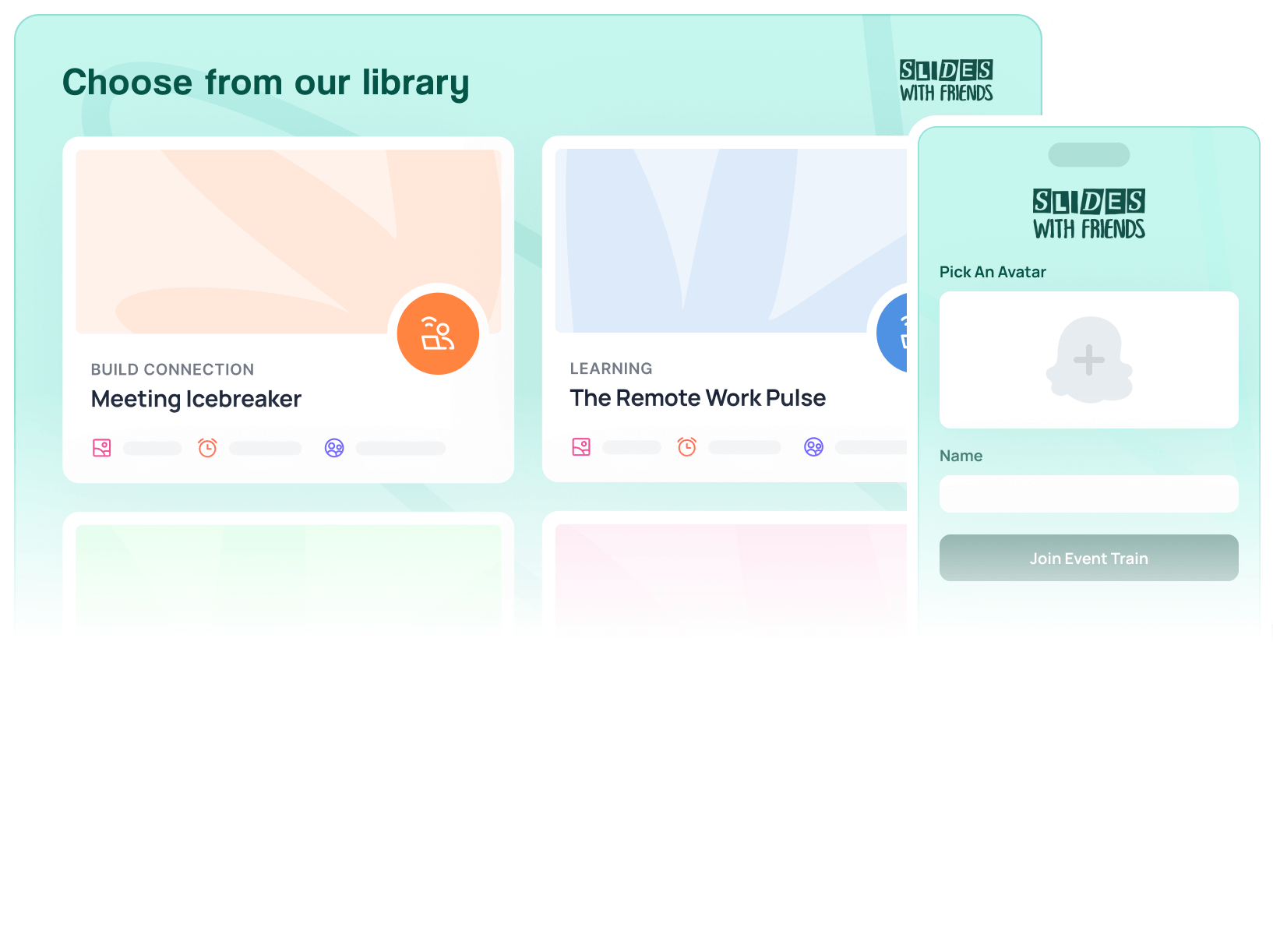How to Make Staff Meetings More Engaging
There are four key elements of group engagement and increasing any one of them will boost your team's engagement in your meetings. Here are some actionable ways to make your meetings more interesting and increase staff participation, whether you're remote, in a conference room, or hybrid.

It’s pretty common in staff meetings to call the team together and see a lot of bored faces or blank video screens. We work hard to make meetings valuable, but it’s hard to gauge how much of that value your workers are getting. Do they feel plugged in? Or should the whole meeting have been shudder an email?
Sometimes, getting participation or feedback can feel like pulling teeth. But it doesn’t have to! There are easy, actionable ways to make team meetings more engaging, whether you’re meeting in-person, remotely, or in a hybrid mix.
Why engagement matters
It seems obvious, but it’s worth looking at the actual science to back us up. According to The Palgrave Handbook of Workplace Well-Being, employee engagement leads to improved productivity, morale, group alignment, and employee retention in the workplace. And engagement during team meetings isn’t just about feeling a flow during your staff’s time together, it’s about improving results across the board post-meeting. A Gallup study found organizations with higher employee engagement perform at higher levels.

Through engagement, you tend to get better input that leads to better decisions, better solutions, and better results.
- Michael Wilkinson, the CEO and Managing Director of Leadership Strategies

What creates engagement in meetings?
There are four key components to group engagement: buy-in, comfort level, interest, and interaction. Increasing any of these will lead to more engagement.
- Buy-in is each person's investment in the meeting itself and their overall willingness to share in your larger goals as a company or unit.
- Comfort level is each individual's feelings of acceptance and welcome-ness within the group, which in turn improves overall communication.
- Interest is how much the current topic is relevant or applies to the individual.
- Interaction is how much each person shares, participates, or is called upon in any way, during the meeting.
There are simple ways to boost and increase engagement in staff meetings by working with each of these components.
1. Getting buy-in that boosts engagement
All good engagement comes from a basis of buy-in. Someone who wants to be there, has the same goals as you, and agrees with your methods of achieving them (or, wants to try) is going to be more helpful and more engaged than a begrudging tag-along.
These simple tactics will help you get team buy-in:
To start, get basic employee buy-in by to setting clear goals together. The ‘why’ of what you’re doing, either individually or as a team, can be a huge motivator for employees and help them feel they’re striving for the same objectives. Step back with your staff and look at the 30,000 foot view. Talk as a group about these larger goals and why they’re important. In these conversations, emphasize how reaching these goals will be valuable for you as a team, but also for each of them individually.
More granularly, start each of your meetings with a set goal, and articulate how achieving that goal will move you all forward. Then at the end of your gatherings, don’t forget to go over the takeaway from the meeting, ie. reiterate that the time they just spent was valuable even in small part, since it (hopefully) was a step along the path toward your shared goals.
If you’re having trouble getting an employee to understand why your shared goals have value, speak one on one with them to see if you can’t find common ground. This sort of buy-in is critical for everyone to understand.
2. Creating a comfortable space for communication
If you’re seeking to get more group connecting and active participating, start by removing barriers to entry in group social settings. Speaking in large groups can be overwhelming, even for the boldest of us. Fortunately, tools and frameworks exist to gently encourage participation. Use them!
Structures and frameworks like games are great for making a space where people are freed to participate (try team building games or icebreaker questions). Then, tech tools are hugely helpful when used well, especially if you’re not in the same room all together. Make liberal use of the Zoom chat (”Where’s everyone calling in from? Type your location in the chat!”), group Slack, or Slides With Friends interaction to help you enable and prompt communication without that high, prohibitive bar of ”Just unmute and talk!”
Next, make sure you’re giving space for every voice. It’s quite normal for the loudest, most dominating voice to take over staff meetings. The introverted and quiet also have important things to say. Whether you’re running a meeting of 50 or 5, make sure you hear something from everyone, even if it’s just in a small way. A great way to hear all voices in a larger group is to use polling and group brainstorming tools like Slides With Friends or Poll Everywhere.
Finally, keep in mind that remote and hybrid meetings have resulted in the loss of certain social cues. We’re stuck in these small boxes where we can’t make eye contact and body language is almost completely unreadable. The loss of these social cues can cause increased cognitive load during meetings. You can take actions to help this: here’s a full blog about Decreasing Zoom Fatigue for your team.
3. Making your meetings more interesting
Let’s be honest: as leaders, some of our meetings are less than stellar.

A portion of the reason staff meetings aren’t encouraging engagement is because we aren’t making them interesting or purposeful.
To start, you want to make sure the right people are in the meeting. As you’re putting your meeting agenda together, ask yourself who the meeting applies to. If a person won’t be contributing to the conversation or won’t be affected by decisions made in the meeting, don’t waste their time. To truly increase engagement, at the beginning of your meeting, explain why each person is in attendance and why what you’re discussing will matter to them. (There are, of course, meetings where you will need everyone involved. Learn How to Host the Perfect All Hands Meeting here.)
Next, if it's not already obviously delineated, give each person or sub group a job or a stated goal. Whether it's note-taking, coming up with options, or determining their own takeaway tasks, when you are personally involved in something, you are automatically much more interested. Give your team this foothold of personal responsibility and they'll automatically be more engaged.
Finally, and we’ll delve into this a bit more in our next section, let your staff participate. A meeting shouldn’t be a monologue. People love to share and having their role, information, or content up for discussion will automatically get them more engaged and boost their overall interest.

4. Getting participation and interaction in meetings
It seems obvious, but enable interaction, make it easy, and you'll get more of it. Set the expectation of interaction early in your meeting, or even when you send out the meeting reminder. People will feel prepared and more comfortable knowing the expectations set on them before the meeting.
To encourage participation, you can make the goal-setting and purpose of the meeting an activity. Start by having each person briefly voice what a successful meeting would look like to them. If you’re in a larger group, you can ask what people want to get out of the meeting in the chat. Better yet, use tools specifically designed for this kind of sharing and make the question a poll or word cloud. Here’s a pre-made Meeting Kickoff Deck you can easily customize start your meeting off strong.

And don’t take yourself too seriously! Play games with your team to warm up or get new ideas rolling. You can start your meetings with a participatory Ice Breaker game. By getting your team to relax and communicate about something besides work, you create a culture of participation that results in improved interaction.

The key takeaways for increasing staff engagement
You can do start doing some simple things today that will make your staff more engaged in your meetings: ensure everyone on the team knows why you're all doing what you're doing. Then create a safe space and remove barriers to participation, making interacting easy. Use tools if that helps.
If you listen to and encourage your team, they will pay you back in kind!



Ready to ditch the dull, and run team sessions that people will actually enjoy?
Get started with a Slides with Friends deck in no time. We’ve got all the interactive features you need in one easy-to-learn, easy-to-set-up tool.















